Dynamics of Strategy: A Comprehensive Strategic Audit of Samsung
VerifiedAdded on 2022/11/18
|71
|10260
|318
Report
AI Summary
This report provides a comprehensive strategic audit of Samsung, examining its internal and external environments. The analysis begins with a historical overview, tracing Samsung's evolution from its inception to its current competitive position, including strategic choices made over time. The report delves into internal factors such as VMOST analysis, product portfolio assessment using the BCG matrix, and financial analysis. It also explores external factors, including customer analysis, competitor analysis, and the competitive industry environment. Strategic fit is evaluated through SWOT analysis, EVR congruence, and a balanced scorecard. The report then moves to strategic direction, risk management, and growth strategic options, assessing the suitability and acceptability of various strategic choices. The conclusion summarizes key findings and provides insights into Samsung's future strategic direction. The report references various academic sources to support its findings and analysis.

Running head: DYNAMICS OF STRATEGY
DYNAMICS OF STRATEGY
Name of the Student
Name of the University
Author Note
DYNAMICS OF STRATEGY
Name of the Student
Name of the University
Author Note
Paraphrase This Document
Need a fresh take? Get an instant paraphrase of this document with our AI Paraphraser
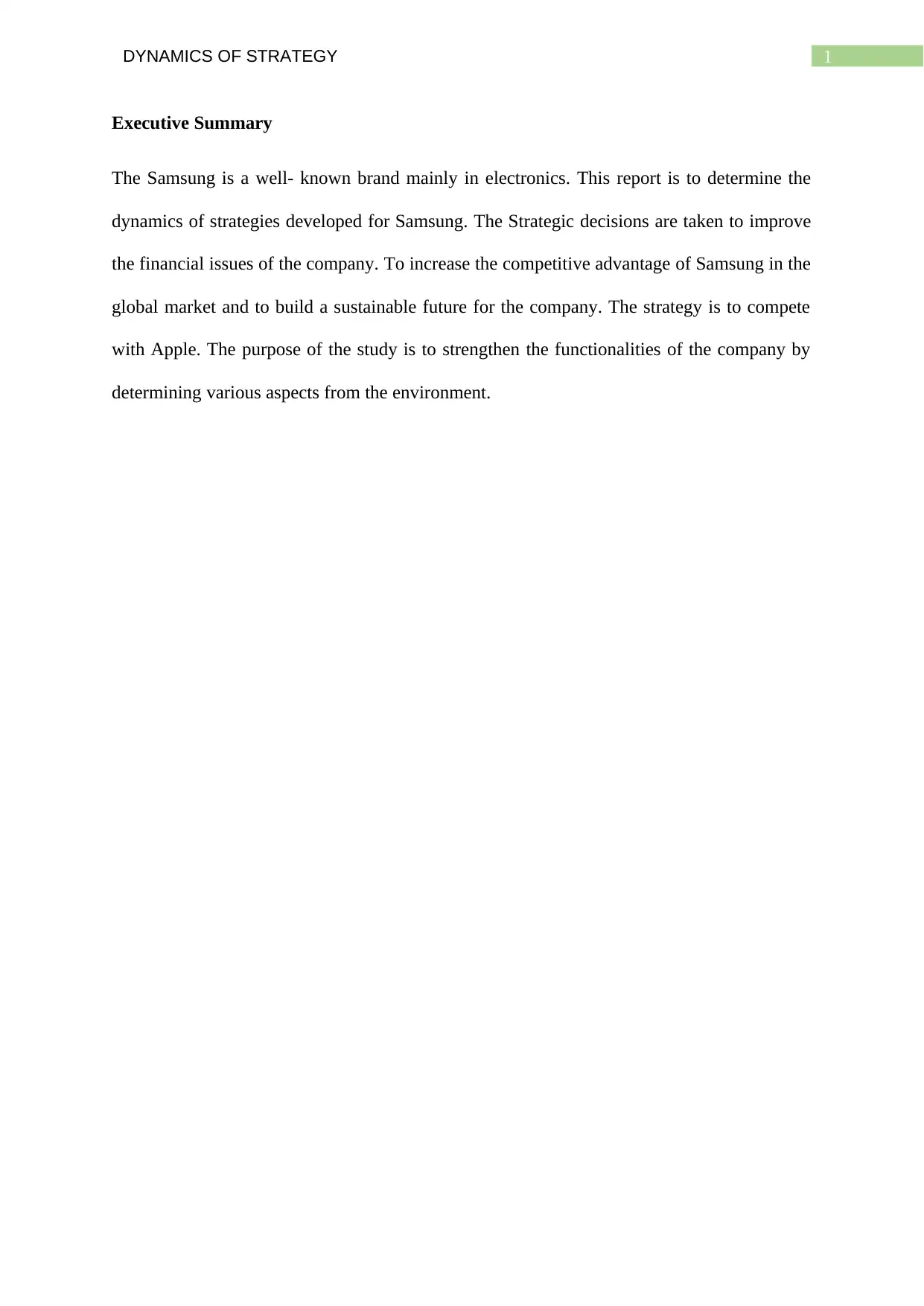
1DYNAMICS OF STRATEGY
Executive Summary
The Samsung is a well- known brand mainly in electronics. This report is to determine the
dynamics of strategies developed for Samsung. The Strategic decisions are taken to improve
the financial issues of the company. To increase the competitive advantage of Samsung in the
global market and to build a sustainable future for the company. The strategy is to compete
with Apple. The purpose of the study is to strengthen the functionalities of the company by
determining various aspects from the environment.
Executive Summary
The Samsung is a well- known brand mainly in electronics. This report is to determine the
dynamics of strategies developed for Samsung. The Strategic decisions are taken to improve
the financial issues of the company. To increase the competitive advantage of Samsung in the
global market and to build a sustainable future for the company. The strategy is to compete
with Apple. The purpose of the study is to strengthen the functionalities of the company by
determining various aspects from the environment.
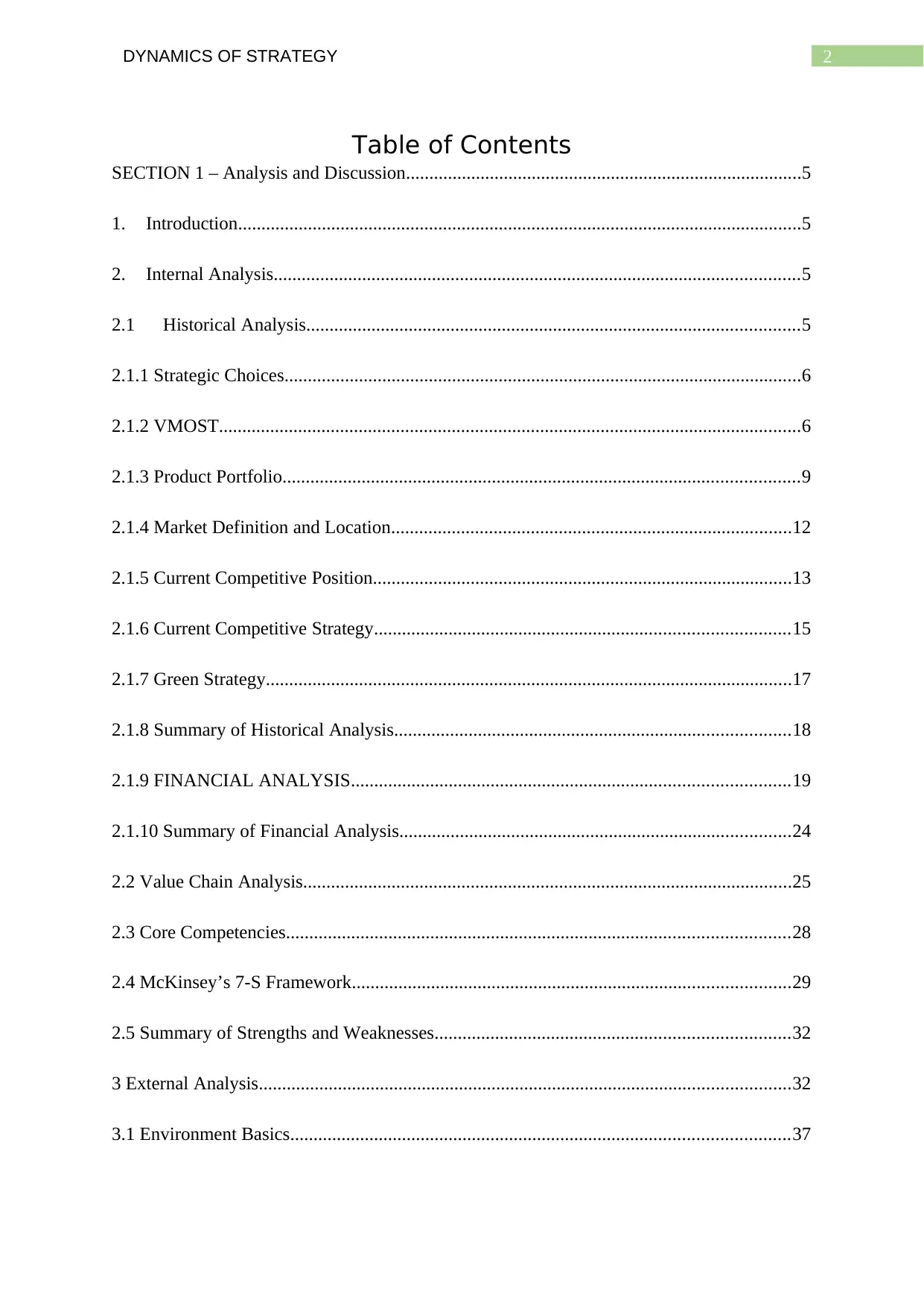
2DYNAMICS OF STRATEGY
Table of Contents
SECTION 1 – Analysis and Discussion.....................................................................................5
1. Introduction.........................................................................................................................5
2. Internal Analysis.................................................................................................................5
2.1 Historical Analysis..........................................................................................................5
2.1.1 Strategic Choices...............................................................................................................6
2.1.2 VMOST.............................................................................................................................6
2.1.3 Product Portfolio...............................................................................................................9
2.1.4 Market Definition and Location......................................................................................12
2.1.5 Current Competitive Position..........................................................................................13
2.1.6 Current Competitive Strategy.........................................................................................15
2.1.7 Green Strategy.................................................................................................................17
2.1.8 Summary of Historical Analysis.....................................................................................18
2.1.9 FINANCIAL ANALYSIS..............................................................................................19
2.1.10 Summary of Financial Analysis....................................................................................24
2.2 Value Chain Analysis.........................................................................................................25
2.3 Core Competencies............................................................................................................28
2.4 McKinsey’s 7-S Framework..............................................................................................29
2.5 Summary of Strengths and Weaknesses............................................................................32
3 External Analysis..................................................................................................................32
3.1 Environment Basics...........................................................................................................37
Table of Contents
SECTION 1 – Analysis and Discussion.....................................................................................5
1. Introduction.........................................................................................................................5
2. Internal Analysis.................................................................................................................5
2.1 Historical Analysis..........................................................................................................5
2.1.1 Strategic Choices...............................................................................................................6
2.1.2 VMOST.............................................................................................................................6
2.1.3 Product Portfolio...............................................................................................................9
2.1.4 Market Definition and Location......................................................................................12
2.1.5 Current Competitive Position..........................................................................................13
2.1.6 Current Competitive Strategy.........................................................................................15
2.1.7 Green Strategy.................................................................................................................17
2.1.8 Summary of Historical Analysis.....................................................................................18
2.1.9 FINANCIAL ANALYSIS..............................................................................................19
2.1.10 Summary of Financial Analysis....................................................................................24
2.2 Value Chain Analysis.........................................................................................................25
2.3 Core Competencies............................................................................................................28
2.4 McKinsey’s 7-S Framework..............................................................................................29
2.5 Summary of Strengths and Weaknesses............................................................................32
3 External Analysis..................................................................................................................32
3.1 Environment Basics...........................................................................................................37
⊘ This is a preview!⊘
Do you want full access?
Subscribe today to unlock all pages.

Trusted by 1+ million students worldwide
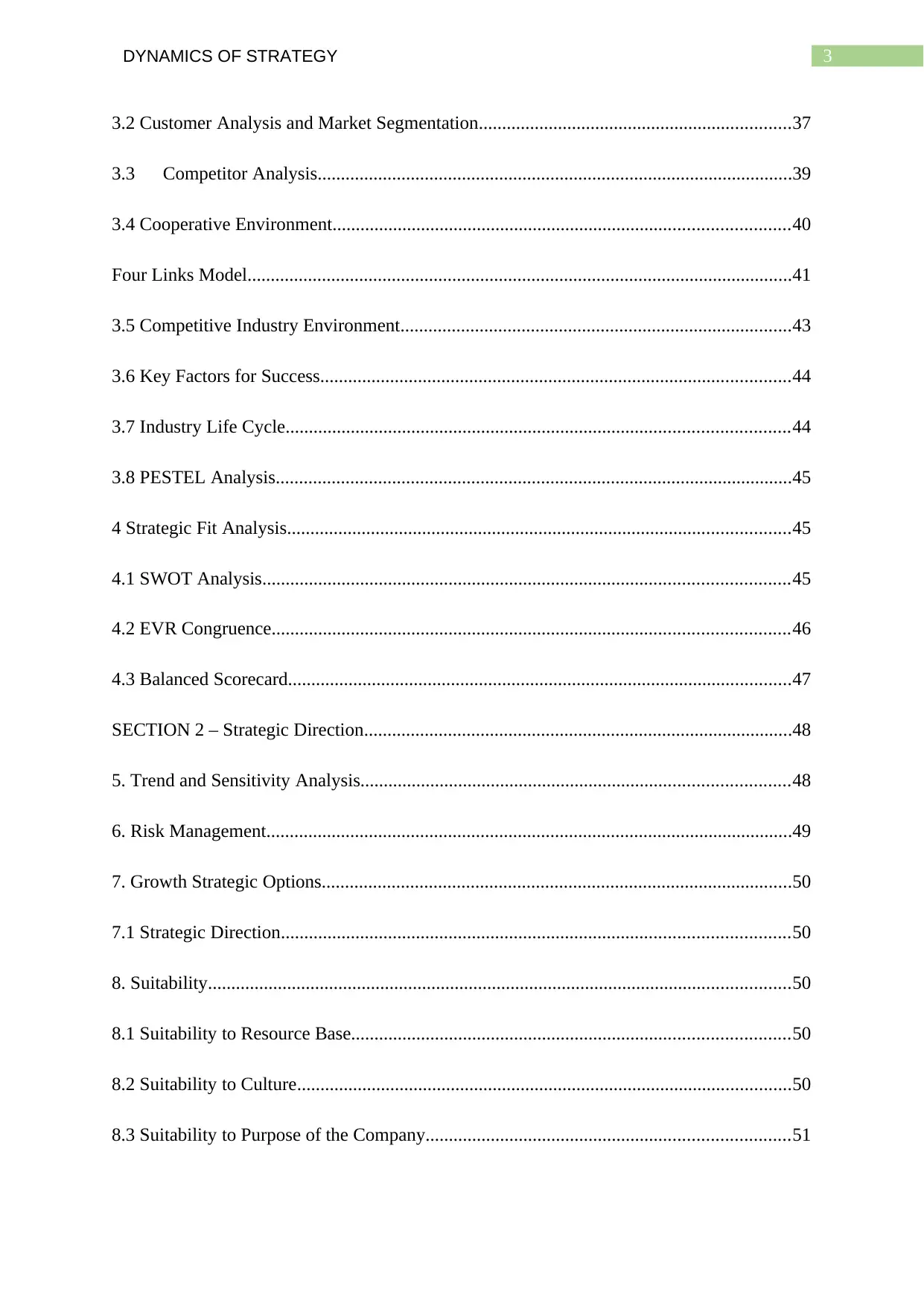
3DYNAMICS OF STRATEGY
3.2 Customer Analysis and Market Segmentation...................................................................37
3.3 Competitor Analysis......................................................................................................39
3.4 Cooperative Environment..................................................................................................40
Four Links Model.....................................................................................................................41
3.5 Competitive Industry Environment....................................................................................43
3.6 Key Factors for Success.....................................................................................................44
3.7 Industry Life Cycle............................................................................................................44
3.8 PESTEL Analysis...............................................................................................................45
4 Strategic Fit Analysis............................................................................................................45
4.1 SWOT Analysis.................................................................................................................45
4.2 EVR Congruence...............................................................................................................46
4.3 Balanced Scorecard............................................................................................................47
SECTION 2 – Strategic Direction............................................................................................48
5. Trend and Sensitivity Analysis............................................................................................48
6. Risk Management.................................................................................................................49
7. Growth Strategic Options.....................................................................................................50
7.1 Strategic Direction.............................................................................................................50
8. Suitability.............................................................................................................................50
8.1 Suitability to Resource Base..............................................................................................50
8.2 Suitability to Culture..........................................................................................................50
8.3 Suitability to Purpose of the Company..............................................................................51
3.2 Customer Analysis and Market Segmentation...................................................................37
3.3 Competitor Analysis......................................................................................................39
3.4 Cooperative Environment..................................................................................................40
Four Links Model.....................................................................................................................41
3.5 Competitive Industry Environment....................................................................................43
3.6 Key Factors for Success.....................................................................................................44
3.7 Industry Life Cycle............................................................................................................44
3.8 PESTEL Analysis...............................................................................................................45
4 Strategic Fit Analysis............................................................................................................45
4.1 SWOT Analysis.................................................................................................................45
4.2 EVR Congruence...............................................................................................................46
4.3 Balanced Scorecard............................................................................................................47
SECTION 2 – Strategic Direction............................................................................................48
5. Trend and Sensitivity Analysis............................................................................................48
6. Risk Management.................................................................................................................49
7. Growth Strategic Options.....................................................................................................50
7.1 Strategic Direction.............................................................................................................50
8. Suitability.............................................................................................................................50
8.1 Suitability to Resource Base..............................................................................................50
8.2 Suitability to Culture..........................................................................................................50
8.3 Suitability to Purpose of the Company..............................................................................51
Paraphrase This Document
Need a fresh take? Get an instant paraphrase of this document with our AI Paraphraser
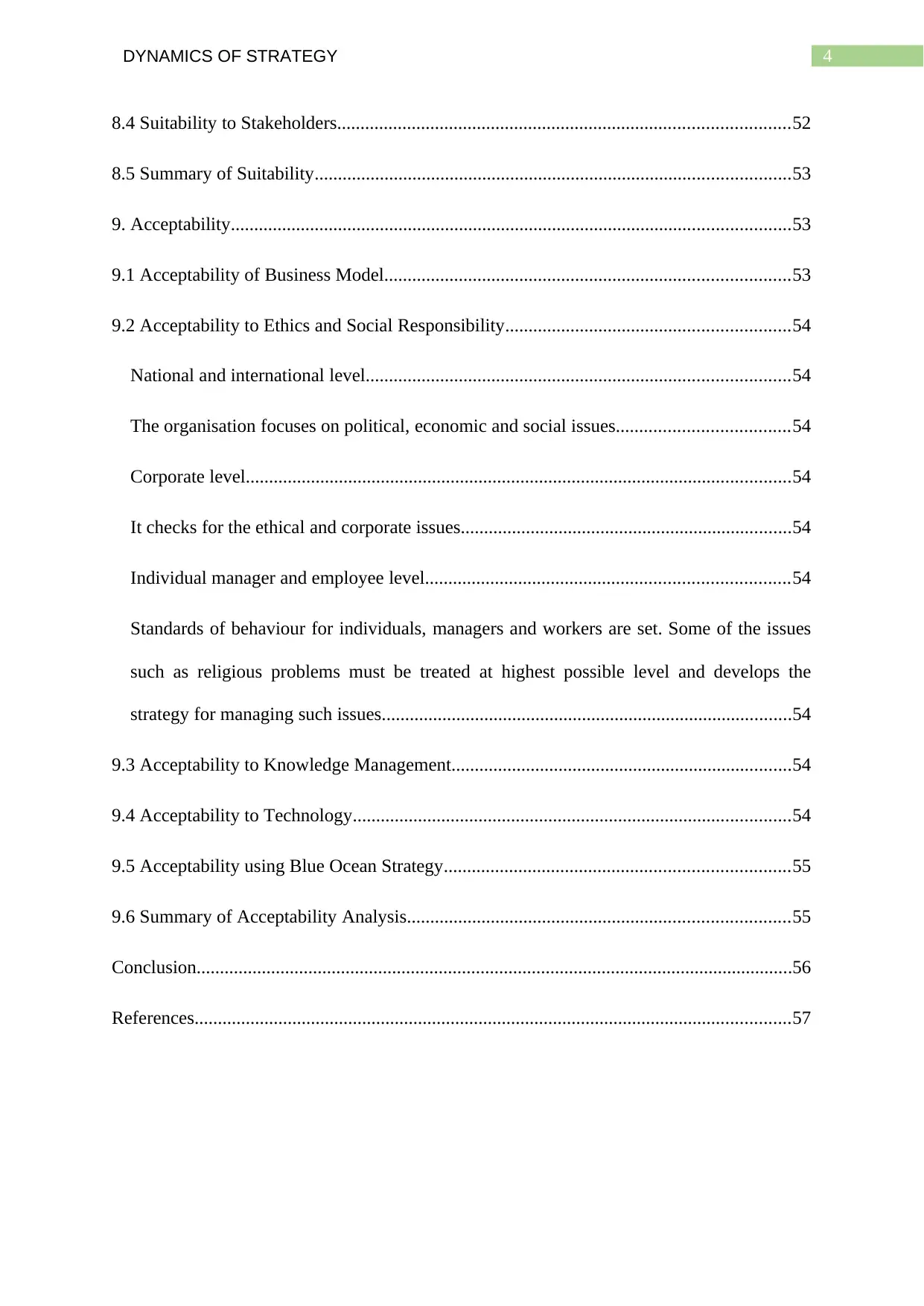
4DYNAMICS OF STRATEGY
8.4 Suitability to Stakeholders.................................................................................................52
8.5 Summary of Suitability......................................................................................................53
9. Acceptability........................................................................................................................53
9.1 Acceptability of Business Model.......................................................................................53
9.2 Acceptability to Ethics and Social Responsibility.............................................................54
National and international level...........................................................................................54
The organisation focuses on political, economic and social issues.....................................54
Corporate level.....................................................................................................................54
It checks for the ethical and corporate issues.......................................................................54
Individual manager and employee level..............................................................................54
Standards of behaviour for individuals, managers and workers are set. Some of the issues
such as religious problems must be treated at highest possible level and develops the
strategy for managing such issues........................................................................................54
9.3 Acceptability to Knowledge Management.........................................................................54
9.4 Acceptability to Technology..............................................................................................54
9.5 Acceptability using Blue Ocean Strategy..........................................................................55
9.6 Summary of Acceptability Analysis..................................................................................55
Conclusion................................................................................................................................56
References................................................................................................................................57
8.4 Suitability to Stakeholders.................................................................................................52
8.5 Summary of Suitability......................................................................................................53
9. Acceptability........................................................................................................................53
9.1 Acceptability of Business Model.......................................................................................53
9.2 Acceptability to Ethics and Social Responsibility.............................................................54
National and international level...........................................................................................54
The organisation focuses on political, economic and social issues.....................................54
Corporate level.....................................................................................................................54
It checks for the ethical and corporate issues.......................................................................54
Individual manager and employee level..............................................................................54
Standards of behaviour for individuals, managers and workers are set. Some of the issues
such as religious problems must be treated at highest possible level and develops the
strategy for managing such issues........................................................................................54
9.3 Acceptability to Knowledge Management.........................................................................54
9.4 Acceptability to Technology..............................................................................................54
9.5 Acceptability using Blue Ocean Strategy..........................................................................55
9.6 Summary of Acceptability Analysis..................................................................................55
Conclusion................................................................................................................................56
References................................................................................................................................57

5DYNAMICS OF STRATEGY
⊘ This is a preview!⊘
Do you want full access?
Subscribe today to unlock all pages.

Trusted by 1+ million students worldwide
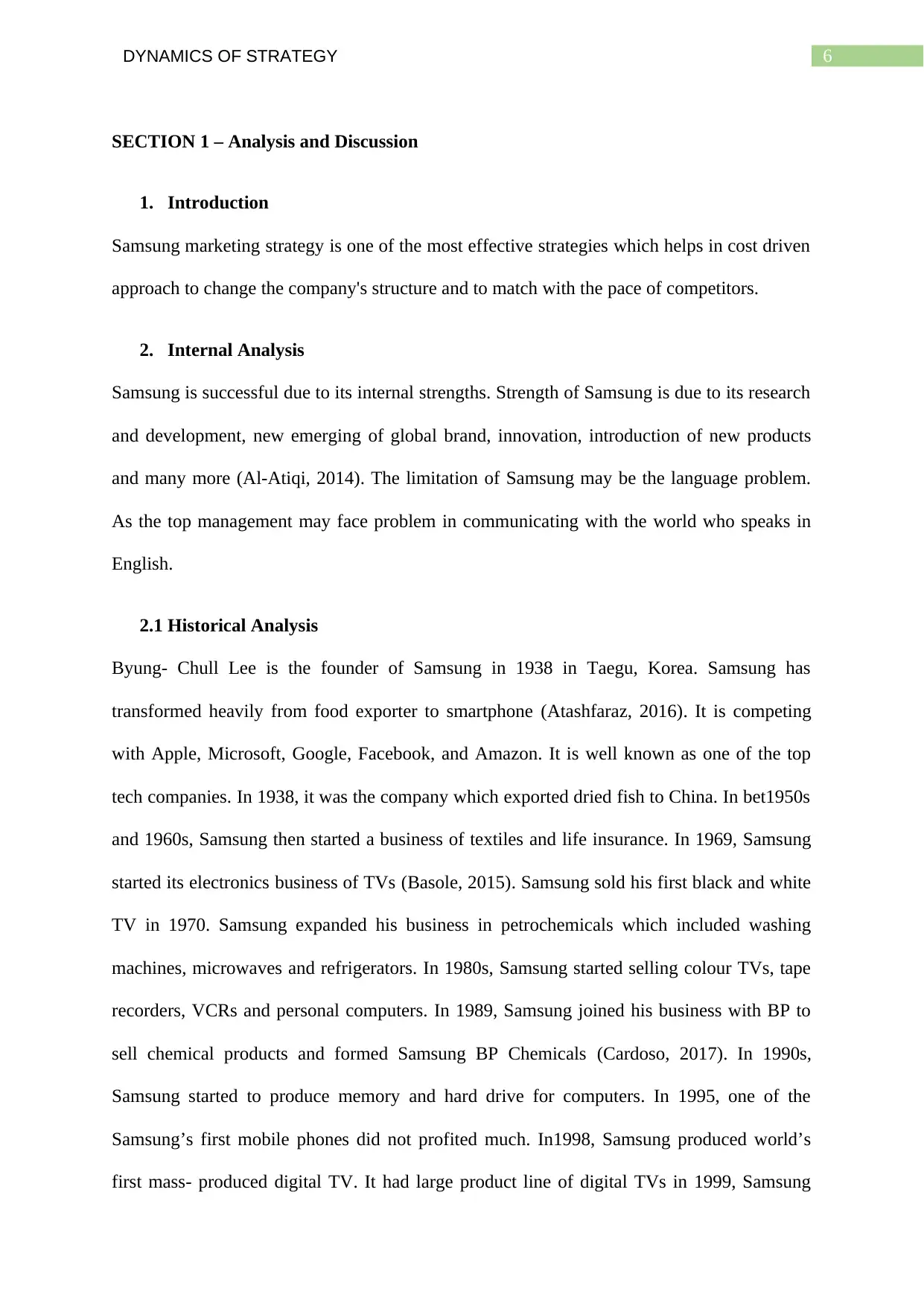
6DYNAMICS OF STRATEGY
SECTION 1 – Analysis and Discussion
1. Introduction
Samsung marketing strategy is one of the most effective strategies which helps in cost driven
approach to change the company's structure and to match with the pace of competitors.
2. Internal Analysis
Samsung is successful due to its internal strengths. Strength of Samsung is due to its research
and development, new emerging of global brand, innovation, introduction of new products
and many more (Al-Atiqi, 2014). The limitation of Samsung may be the language problem.
As the top management may face problem in communicating with the world who speaks in
English.
2.1 Historical Analysis
Byung- Chull Lee is the founder of Samsung in 1938 in Taegu, Korea. Samsung has
transformed heavily from food exporter to smartphone (Atashfaraz, 2016). It is competing
with Apple, Microsoft, Google, Facebook, and Amazon. It is well known as one of the top
tech companies. In 1938, it was the company which exported dried fish to China. In bet1950s
and 1960s, Samsung then started a business of textiles and life insurance. In 1969, Samsung
started its electronics business of TVs (Basole, 2015). Samsung sold his first black and white
TV in 1970. Samsung expanded his business in petrochemicals which included washing
machines, microwaves and refrigerators. In 1980s, Samsung started selling colour TVs, tape
recorders, VCRs and personal computers. In 1989, Samsung joined his business with BP to
sell chemical products and formed Samsung BP Chemicals (Cardoso, 2017). In 1990s,
Samsung started to produce memory and hard drive for computers. In 1995, one of the
Samsung’s first mobile phones did not profited much. In1998, Samsung produced world’s
first mass- produced digital TV. It had large product line of digital TVs in 1999, Samsung
SECTION 1 – Analysis and Discussion
1. Introduction
Samsung marketing strategy is one of the most effective strategies which helps in cost driven
approach to change the company's structure and to match with the pace of competitors.
2. Internal Analysis
Samsung is successful due to its internal strengths. Strength of Samsung is due to its research
and development, new emerging of global brand, innovation, introduction of new products
and many more (Al-Atiqi, 2014). The limitation of Samsung may be the language problem.
As the top management may face problem in communicating with the world who speaks in
English.
2.1 Historical Analysis
Byung- Chull Lee is the founder of Samsung in 1938 in Taegu, Korea. Samsung has
transformed heavily from food exporter to smartphone (Atashfaraz, 2016). It is competing
with Apple, Microsoft, Google, Facebook, and Amazon. It is well known as one of the top
tech companies. In 1938, it was the company which exported dried fish to China. In bet1950s
and 1960s, Samsung then started a business of textiles and life insurance. In 1969, Samsung
started its electronics business of TVs (Basole, 2015). Samsung sold his first black and white
TV in 1970. Samsung expanded his business in petrochemicals which included washing
machines, microwaves and refrigerators. In 1980s, Samsung started selling colour TVs, tape
recorders, VCRs and personal computers. In 1989, Samsung joined his business with BP to
sell chemical products and formed Samsung BP Chemicals (Cardoso, 2017). In 1990s,
Samsung started to produce memory and hard drive for computers. In 1995, one of the
Samsung’s first mobile phones did not profited much. In1998, Samsung produced world’s
first mass- produced digital TV. It had large product line of digital TVs in 1999, Samsung
Paraphrase This Document
Need a fresh take? Get an instant paraphrase of this document with our AI Paraphraser

7DYNAMICS OF STRATEGY
then began to produce Internet- ready phones. Samsung made HD TVs in 2000 which then
turned to Blu- Ray players and theatre equipment (Chen, 2016). In 2010, Samsung introduced
its first flagship Android phone at the Mobile World Congress, the third generation phone;
Galaxy S. Samsung also released the first mainstream Android tablet; Galaxy Tab in 2010
(Chopra, 2014). In 2013, Samsung introduced Smart TVs which had programmed data from
the satellite provider and provided with numerous channels and shows.
2.1.1 Strategic Choices
Samsung uses Limited Growth Strategies. This strategy is used by the organisation to focus
on the current product which are being produced. The global strategy Group (GSG) of
Samsung helps to improve business performance and develop more talent (Daidj, 2014).
2.1.2 VMOST
Vision and Mission
then began to produce Internet- ready phones. Samsung made HD TVs in 2000 which then
turned to Blu- Ray players and theatre equipment (Chen, 2016). In 2010, Samsung introduced
its first flagship Android phone at the Mobile World Congress, the third generation phone;
Galaxy S. Samsung also released the first mainstream Android tablet; Galaxy Tab in 2010
(Chopra, 2014). In 2013, Samsung introduced Smart TVs which had programmed data from
the satellite provider and provided with numerous channels and shows.
2.1.1 Strategic Choices
Samsung uses Limited Growth Strategies. This strategy is used by the organisation to focus
on the current product which are being produced. The global strategy Group (GSG) of
Samsung helps to improve business performance and develop more talent (Daidj, 2014).
2.1.2 VMOST
Vision and Mission
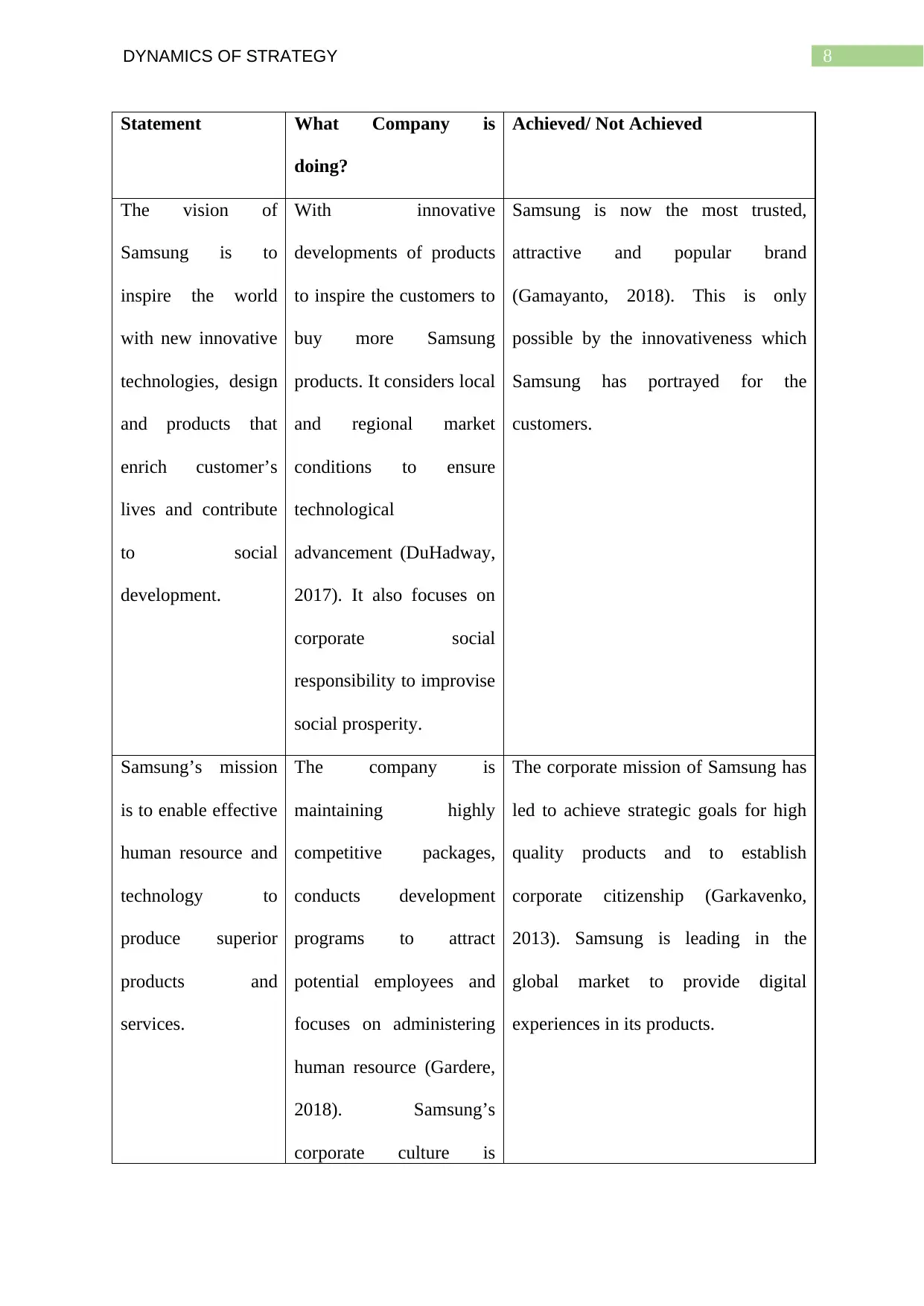
8DYNAMICS OF STRATEGY
Statement What Company is
doing?
Achieved/ Not Achieved
The vision of
Samsung is to
inspire the world
with new innovative
technologies, design
and products that
enrich customer’s
lives and contribute
to social
development.
With innovative
developments of products
to inspire the customers to
buy more Samsung
products. It considers local
and regional market
conditions to ensure
technological
advancement (DuHadway,
2017). It also focuses on
corporate social
responsibility to improvise
social prosperity.
Samsung is now the most trusted,
attractive and popular brand
(Gamayanto, 2018). This is only
possible by the innovativeness which
Samsung has portrayed for the
customers.
Samsung’s mission
is to enable effective
human resource and
technology to
produce superior
products and
services.
The company is
maintaining highly
competitive packages,
conducts development
programs to attract
potential employees and
focuses on administering
human resource (Gardere,
2018). Samsung’s
corporate culture is
The corporate mission of Samsung has
led to achieve strategic goals for high
quality products and to establish
corporate citizenship (Garkavenko,
2013). Samsung is leading in the
global market to provide digital
experiences in its products.
Statement What Company is
doing?
Achieved/ Not Achieved
The vision of
Samsung is to
inspire the world
with new innovative
technologies, design
and products that
enrich customer’s
lives and contribute
to social
development.
With innovative
developments of products
to inspire the customers to
buy more Samsung
products. It considers local
and regional market
conditions to ensure
technological
advancement (DuHadway,
2017). It also focuses on
corporate social
responsibility to improvise
social prosperity.
Samsung is now the most trusted,
attractive and popular brand
(Gamayanto, 2018). This is only
possible by the innovativeness which
Samsung has portrayed for the
customers.
Samsung’s mission
is to enable effective
human resource and
technology to
produce superior
products and
services.
The company is
maintaining highly
competitive packages,
conducts development
programs to attract
potential employees and
focuses on administering
human resource (Gardere,
2018). Samsung’s
corporate culture is
The corporate mission of Samsung has
led to achieve strategic goals for high
quality products and to establish
corporate citizenship (Garkavenko,
2013). Samsung is leading in the
global market to provide digital
experiences in its products.
⊘ This is a preview!⊘
Do you want full access?
Subscribe today to unlock all pages.

Trusted by 1+ million students worldwide
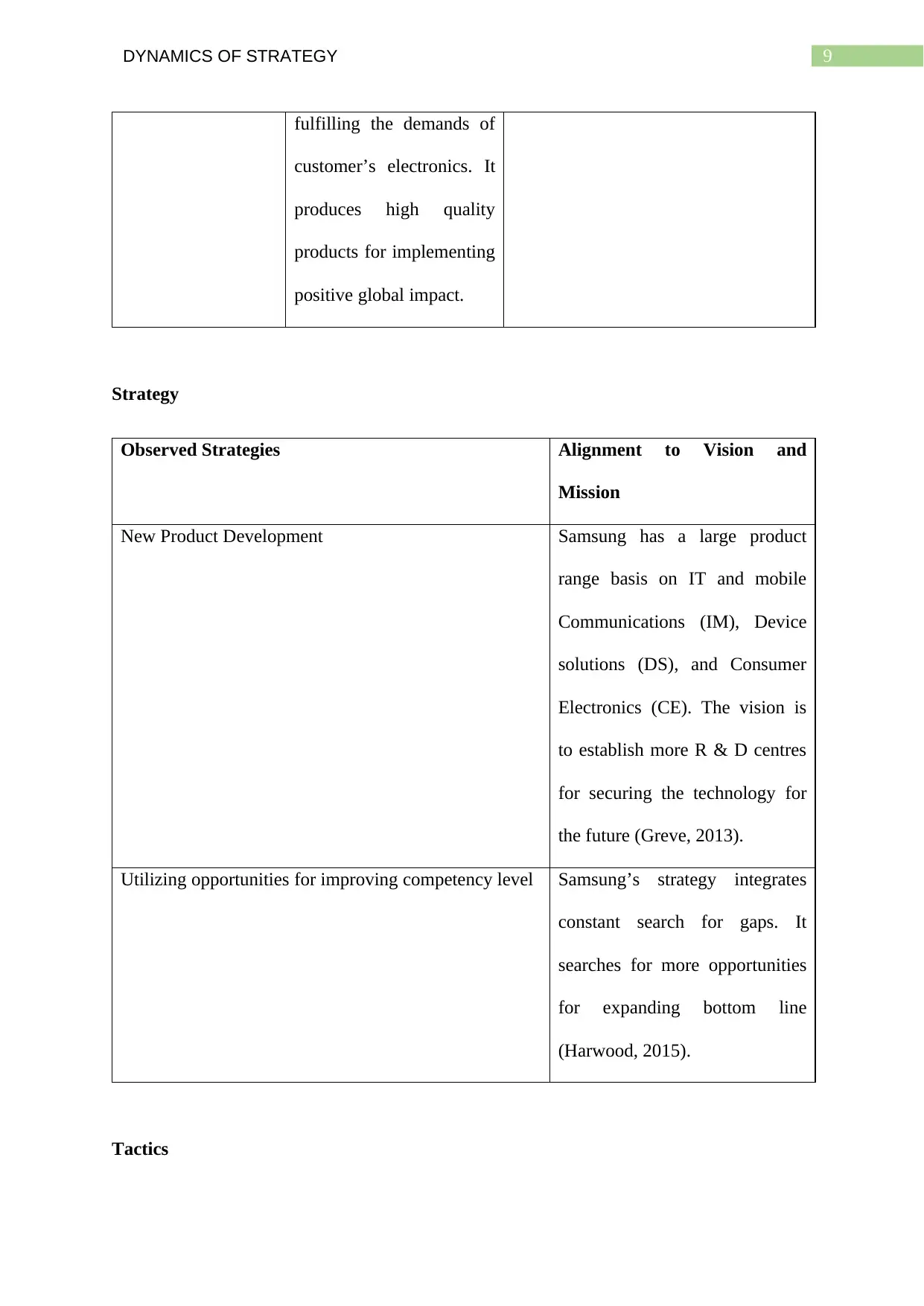
9DYNAMICS OF STRATEGY
fulfilling the demands of
customer’s electronics. It
produces high quality
products for implementing
positive global impact.
Strategy
Observed Strategies Alignment to Vision and
Mission
New Product Development Samsung has a large product
range basis on IT and mobile
Communications (IM), Device
solutions (DS), and Consumer
Electronics (CE). The vision is
to establish more R & D centres
for securing the technology for
the future (Greve, 2013).
Utilizing opportunities for improving competency level Samsung’s strategy integrates
constant search for gaps. It
searches for more opportunities
for expanding bottom line
(Harwood, 2015).
Tactics
fulfilling the demands of
customer’s electronics. It
produces high quality
products for implementing
positive global impact.
Strategy
Observed Strategies Alignment to Vision and
Mission
New Product Development Samsung has a large product
range basis on IT and mobile
Communications (IM), Device
solutions (DS), and Consumer
Electronics (CE). The vision is
to establish more R & D centres
for securing the technology for
the future (Greve, 2013).
Utilizing opportunities for improving competency level Samsung’s strategy integrates
constant search for gaps. It
searches for more opportunities
for expanding bottom line
(Harwood, 2015).
Tactics
Paraphrase This Document
Need a fresh take? Get an instant paraphrase of this document with our AI Paraphraser
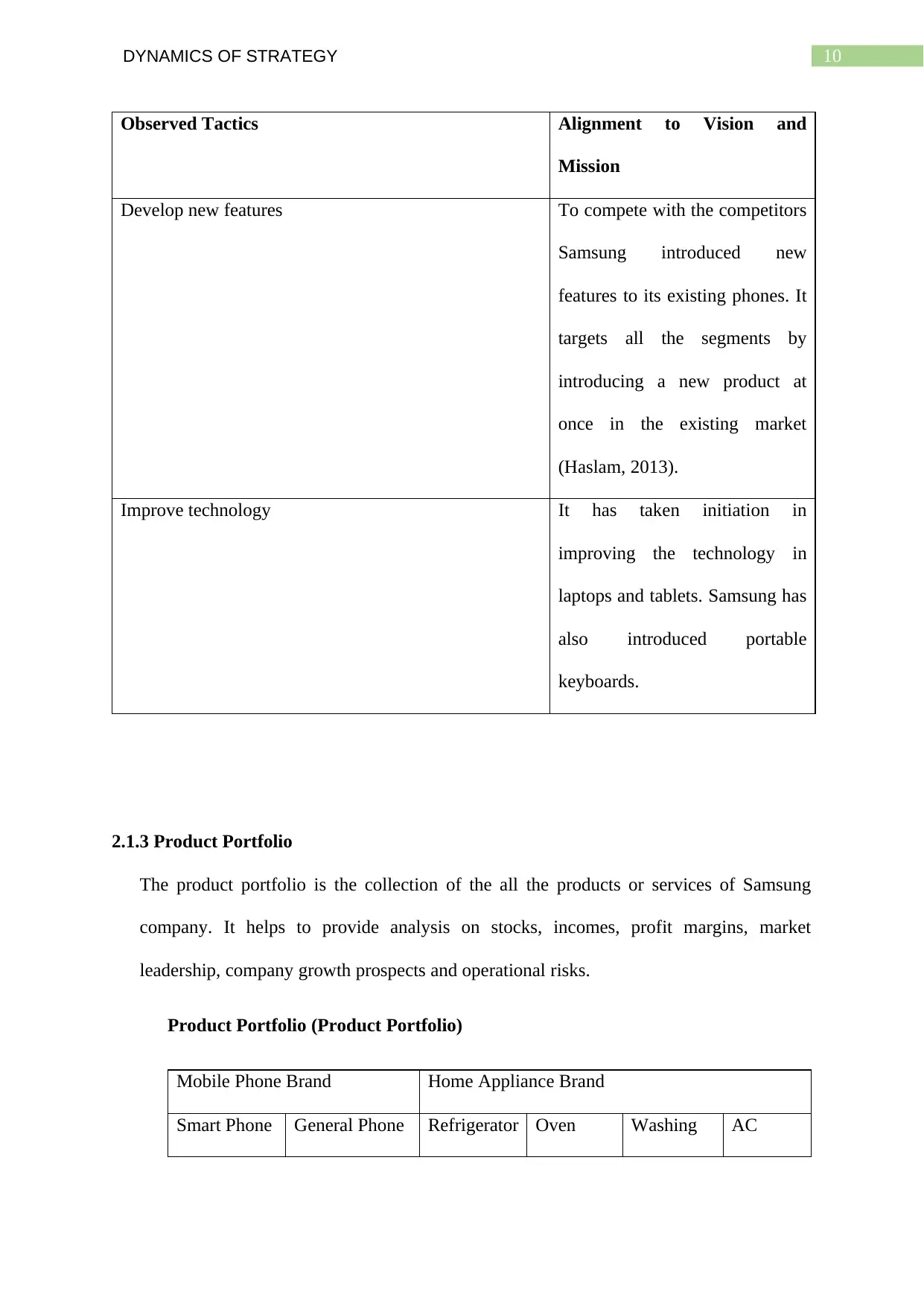
10DYNAMICS OF STRATEGY
Observed Tactics Alignment to Vision and
Mission
Develop new features To compete with the competitors
Samsung introduced new
features to its existing phones. It
targets all the segments by
introducing a new product at
once in the existing market
(Haslam, 2013).
Improve technology It has taken initiation in
improving the technology in
laptops and tablets. Samsung has
also introduced portable
keyboards.
2.1.3 Product Portfolio
The product portfolio is the collection of the all the products or services of Samsung
company. It helps to provide analysis on stocks, incomes, profit margins, market
leadership, company growth prospects and operational risks.
Product Portfolio (Product Portfolio)
Mobile Phone Brand Home Appliance Brand
Smart Phone General Phone Refrigerator Oven Washing AC
Observed Tactics Alignment to Vision and
Mission
Develop new features To compete with the competitors
Samsung introduced new
features to its existing phones. It
targets all the segments by
introducing a new product at
once in the existing market
(Haslam, 2013).
Improve technology It has taken initiation in
improving the technology in
laptops and tablets. Samsung has
also introduced portable
keyboards.
2.1.3 Product Portfolio
The product portfolio is the collection of the all the products or services of Samsung
company. It helps to provide analysis on stocks, incomes, profit margins, market
leadership, company growth prospects and operational risks.
Product Portfolio (Product Portfolio)
Mobile Phone Brand Home Appliance Brand
Smart Phone General Phone Refrigerator Oven Washing AC

11DYNAMICS OF STRATEGY
Machine
Tablet-
Galaxy Tab
Note-
Galaxy Note
Smart
Phones-Note
Gear
Trend
Core
Mega
Essential
Series-Guru
Multimedia
Series-
Metro
Dual Sim
Phone-
Trend
Touch-
Galaxy
Metro
French Door
Side by side
Frost Free
Direct Cool
Bottom
Freezer
Micro
Oven-
Convection
Grill
Solo
Smart
oven
Front
loading-
WD
Top
Loading-
FA
Semi-
Automatic
WT
Split
AC-
DI
Max
Crystal
Floor
Standing
AC-
Boracay
Purist
pattern
S-P
Personal
Computer
Monitor Optimal Disk
Drive
Printers
Desktop
PC
All in one
PC
Only CPU
3D Monitors
Wide
Square
Led
Monitors
CD ROM
Drivers
Combo Drive
DVD Writers
Laser
Printers
Colour
Black-
White
Micro
Oven-
Convection
Grill
Solo
Machine
Tablet-
Galaxy Tab
Note-
Galaxy Note
Smart
Phones-Note
Gear
Trend
Core
Mega
Essential
Series-Guru
Multimedia
Series-
Metro
Dual Sim
Phone-
Trend
Touch-
Galaxy
Metro
French Door
Side by side
Frost Free
Direct Cool
Bottom
Freezer
Micro
Oven-
Convection
Grill
Solo
Smart
oven
Front
loading-
WD
Top
Loading-
FA
Semi-
Automatic
WT
Split
AC-
DI
Max
Crystal
Floor
Standing
AC-
Boracay
Purist
pattern
S-P
Personal
Computer
Monitor Optimal Disk
Drive
Printers
Desktop
PC
All in one
PC
Only CPU
3D Monitors
Wide
Square
Led
Monitors
CD ROM
Drivers
Combo Drive
DVD Writers
Laser
Printers
Colour
Black-
White
Micro
Oven-
Convection
Grill
Solo
⊘ This is a preview!⊘
Do you want full access?
Subscribe today to unlock all pages.

Trusted by 1+ million students worldwide
1 out of 71
Related Documents
Your All-in-One AI-Powered Toolkit for Academic Success.
+13062052269
info@desklib.com
Available 24*7 on WhatsApp / Email
![[object Object]](/_next/static/media/star-bottom.7253800d.svg)
Unlock your academic potential
Copyright © 2020–2025 A2Z Services. All Rights Reserved. Developed and managed by ZUCOL.





